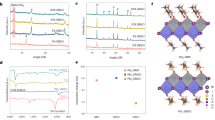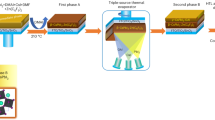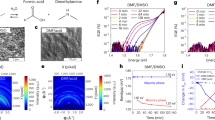Abstract
α-FA1−xCsxPbI3 is a promising absorbent material for efficient and stable perovskite solar cells (PSCs)1,2. However, the most efficient α-FA1−xCsxPbI3 PSCs require the inclusion of the additive methylammonium chloride3,4, which generates volatile organic residues (methylammonium) that limit device stability at elevated temperatures5. Previously, the highest certified power-conversion efficiency of α-FA1−xCsxPbI3 PSCs without methylammonium chloride was only approximately 24% (refs. 6,7), and these PSCs have yet to exhibit any stability advantages. Here we identify interfacial contact loss caused by the accumulation of Cs+ in conventional α-FA1−xCsxPbI3 PSCs, which deteriorates device performance and stability. Through in situ grazing-incidence wide-angle X-ray scattering analysis and density functional theory calculations, we demonstrate an intermediate-phase-assisted crystallization pathway enabled by acetate surface coordination to fabricate high-quality α-FA1−xCsxPbI3 films, without using the methylammonium additive. We herein report a certified stabilized power output efficiency of 25.94% and a reverse-scanning power-conversion efficiency of 26.64% for α-FA1−xCsxPbI3 PSCs. Moreover, the devices exhibited negligible contact losses and enhanced operational stability. They retained over 95% of their initial power-conversion efficiency after operating for over 2,000 h at the maximum power point under 1 sun, 85 °C and 60% relative humidity (ISOS-L-3).
This is a preview of subscription content, access via your institution
Access options
Access Nature and 54 other Nature Portfolio journals
Get Nature+, our best-value online-access subscription
$32.99 / 30 days
cancel any time
Subscribe to this journal
Receive 51 print issues and online access
$199.00 per year
only $3.90 per issue
Buy this article
- Purchase on SpringerLink
- Instant access to full article PDF
Prices may be subject to local taxes which are calculated during checkout




Similar content being viewed by others
Data availability
All data are available in the Article or the Supplementary Information. Other data that support the findings of this study are available from the corresponding author upon reasonable request.
References
Deng, Y. et al. Defect compensation in formamidinium-cesium perovskites for highly efficient solar mini-modules with improved photostability. Nat. Energy 6, 633–641 (2021).
Park, N.-G., Grätzel, M., Miyasaka, T., Zhu, K. & Emery, K. Towards stable and commercially available perovskite solar cells. Nat. Energy 1, 16152 (2016).
Liang, Z. et al. Homogenizing out-of-plane cation composition in perovskite solar cells. Nature 624, 557–563 (2023).
Liu, S. et al. Buried interface molecular hybrid for inverted perovskite solar cells. Nature 632, 536–542 (2024).
Jeong, J. et al. Pseudo-halide anion engineering for α-FAPbI3 perovskite solar cells. Nature 592, 381–385 (2021).
Chen, R. et al. Reduction of bulk and surface defects in inverted methylammonium- and bromide-free formamidinium perovskite solar cells. Nat. Energy 8, 839–849 (2023).
Li, H. et al. 2D/3D heterojunction engineering at the buried interface towards high-performance inverted methylammonium-free perovskite solar cells. Nat. Energy 8, 946–955 (2023).
Green, M. A. et al. Solar cell efficiency tables (version 64). Prog. Photovolt.: Res. Appl. 32, 425–441 (2024).
Liu, X. et al. Stabilization of photoactive phases for perovskite photovoltaics. Nat. Rev. Chem. 7, 462–479 (2023).
Doherty, T. et al. Stabilized tilted-octahedra halide perovskites inhibit local formation of performance-limiting phases. Science 374, 1598–1605 (2021).
Conings, B. et al. Intrinsic thermal instability of methylammonium lead trihalide perovskite. Adv. Energy Mater. 5, 1500477 (2015).
Bai, Y. et al. Initializing film homogeneity to retard phase segregation for stable perovskite solar cells. Science 378, 747–754 (2022).
Park, J. et al. Controlled growth of perovskite layers with volatile alkylammonium chlorides. Nature 616, 724–730 (2023).
Zhang, T. et al. Ion-modulated radical doping of spiro-OMeTAD for more efficient and stable perovskite solar cells. Science 377, 495–501 (2022).
You, S. et al. Radical polymeric p-doping and grain modulation for stable, efficient perovskite solar modules. Science 379, 288–294 (2023).
Chen, Y. et al. Strain engineering and epitaxial stabilization of halide perovskites. Nature 577, 209–215 (2020).
Zhang, H. et al. Multimodal host-guest complexation for efficient and stable perovskite photovoltaics. Nat. Commun. 12, 3383 (2021).
Chen, H. et al. Regulating surface potential maximizes voltage in all-perovskite tandems. Nature 613, 676–681 (2023).
Chen, S. et al. Crystallization in one-step solution deposition of perovskite films: upward or downward? Sci. Adv. 7, eabb2412 (2021).
Bu, T. et al. Modulating crystal growth of formamidinium-caesium perovskites for over 200 cm2 photovoltaic sub-modules. Nat. Energy 7, 528–536 (2022).
Saliba, M. et al. Cesium-containing triple cation perovskite solar cells: improved stability, reproducibility and high efficiency. Energy Environ. Sci. 9, 1989–1997 (2016).
Li, N. et al. Microscopic degradation in formamidinium-cesium lead iodide perovskite solar cells under operational stressors. Joule 4, 1743–1758 (2020).
Qin, M. et al. Manipulating the mixed-perovskite crystallization pathway unveiled by in situ GIWAXS. Adv. Mater. 31, 1901284 (2019).
Yi, C. et al. Entropic stabilization of mixed A-cation ABX3 metal halide perovskites for high performance perovskite solar cells. Energy Environ. Sci. 9, 656–662 (2016).
Fu, Y. et al. Stabilization of the metastable lead iodide perovskite phase via surface functionalization. Nano Lett. 17, 4405–4414 (2017).
Lu, H. et al. Vapor-assisted deposition of highly efficient, stable black-phase FAPbI3 perovskite solar cells. Science 370, eabb8985 (2020).
Yan, L. et al. Fabrication of perovskite solar cells in ambient air by blocking perovskite hydration with guanabenz acetate salt. Nat. Energy 8, 1158–1167 (2023).
Ren, N. et al. Multifunctional additive CdAc2 for efficient perovskite-based solar cells. Adv. Mater. 35, 2211806 (2023).
Kim, B. J. & Boschloo, G. Beneficial effects of cesium acetate in the sequential deposition method for perovskite solar cells. Nanoscale 13, 11478–11487 (2021).
Wang, C. et al. Enhancing performance of tin-based perovskite solar cells via fused-ring electron acceptor. eScience 3, 100113 (2023).
Kirchartz, T., Márquez, J., Stolterfoht, M. & Unold, T. Photoluminescence-based characterization of halide perovskites for photovoltaics. Adv. Energy Mater. 10, 1904134 (2020).
Stolterfoht, M. et al. Visualization and suppression of interfacial recombination for high-efficiency large-area pin perovskite solar cells. Nat. Energy 3, 847–854 (2018).
Zhang, H. & Park, N.-G. Towards sustainability with self-healing and recyclable perovskite solar cells. eScience 2, 567–572 (2022).
Shi, L. et al. Gas chromatography-mass spectrometry analyses of encapsulated stable perovskite solar cells. Science 368, eaba2412 (2020).
Gao, H. et al. Homogeneous crystallization and buried interface passivation for perovskite tandem solar modules. Science 383, 855–859 (2024).
Benecke, G. et al. A customizable software for fast reduction and analysis of large X-ray scattering data sets: applications of the new DPDAK package to small-angle X-ray scattering and grazing-incidence small-angle X-ray scattering. J. Appl. Crystallogr. 47, 1797–1803 (2014).
Jiang, Z. GIXSGUI: a MATLAB toolbox for grazing-incidence X-ray scattering data visualization and reduction, and indexing of buried three-dimensional periodic nanostructured films. J. Appl. Crystallogr. 48, 917–926 (2015).
Kresse, G. & Furthmüller, J. Efficient iterative schemes for ab initio total-energy calculations using a plane-wave basis set. Phys. Rev. B 54, 11169–11186 (1996).
Perdew, J., Burke, K. & Ernzerhof, M. Generalized gradient approximation made simple. Phys. Rev. Lett. 77, 3865–3868 (1996).
Lee, K. et al. Higher-accuracy van der Waals density functional. Phys. Rev. B 82, 081101 (2010).
Henkelman, G., Uberuaga, B. & Jónsson, H. A climbing image nudged elastic band method for finding saddle points and minimum energy paths. J. Chem. Phys. 113, 9901–9904 (2000).
Kühne, T. D. et al. CP2K: An electronic structure and molecular dynamics software package-Quickstep: efficient and accurate electronic structure calculations. J. Chem. Phys. 152, 194103 (2020).
Martínez, L., Andrade, R., Birgin, E. G. & Martínez, J. M. PACKMOL: a package for building initial configurations for molecular dynamics simulations. J. Comput. Chem. 30, 2157–2164 (2009).
Nosé, S. A unified formulation of the constant temperature molecular dynamics methods. J. Chem. Phys. 81, 511–519 (1984).
VandeVondele, J. & Hutter, J. Gaussian basis sets for accurate calculations on molecular systems in gas and condensed phases. J. Chem. Phys. 127, 114105 (2007).
Goedecker, S., Teter, M. & Hutter, J. Separable dual-space Gaussian pseudopotentials. Phys. Rev. B 54, 1703–1710 (1996).
Acknowledgements
This work is financially supported by the National Science Fund for Distinguished Young Scholars (Grant No. T2225024) and the Foundation for Innovative Research Groups of the National Natural Science Foundation of China (Grant No. 22121005). We extend our appreciation to the Deputyship for Research and Innovation, Ministry of Education in Saudi Arabia for funding this research work (Project No. IFKSU-DSR-NS1). We thank the staff of beamlines BL02U2, BL17B1, BL14B1, BL19U2 and BL01B1 at the Shanghai Synchrotron Radiation Facility for providing the beam time and the staff of the User Experiment Assist System of the Shanghai Synchrotron Radiation Facility for their help. This work was partly supported by Analysis Platform of New Matter Structure at Nankai University.
Author information
Authors and Affiliations
Contributions
M.Y., Y.J. and S.L. conceived the idea. M.Y., J.C. and E.H.S. supervised the project. S.L., D.W. and Z.D. fabricated the devices. J.X. and T.Z. did the DFT calculations. S.L., D.W., Y.C., Y.Y., R.G. and Z.D. were responsible for the GIWAXS characterization. S.L., D.W., Z.D., C.S. and K.W. carried out the electrical and optical characterizations. S.M.H.Q. performed the device simulations. M.Y., Y.J., S.L. and E.H.S. co-wrote the manuscript. All authors contributed to the discussion and commented on the manuscript.
Corresponding authors
Ethics declarations
Competing interests
The authors have filed a provisional patent for this work with the China National Intellectual Property Administration. The authors declare no other competing interests.
Peer review
Peer review information
Nature thanks Wei Chen, Jun Zhu and the other, anonymous, reviewer(s) for their contribution to the peer review of this work.
Additional information
Publisher’s note Springer Nature remains neutral with regard to jurisdictional claims in published maps and institutional affiliations.
Extended data figures and tables
Extended Data Fig. 1 Device characterization.
a-d, Comparison of (a) PCE, (b) FF, (c) Jsc, and (d) Voc for pristine and IPA α-FA0.94Cs0.06PbI3-based devices. The Voc, Jsc, FF, and PCE were extracted from 36 devices’ reverse scan J-V curves. e, J-V curves of our champion pristine α-FA0.94Cs0.06PbI3 device. The detailed performance parameters are inserted in the figure. f, EQE spectra and integrated current (Jsc) of the IPA α-FA0.94Cs0.06PbI3 device. By integrating the EQE over the AM 1.5 G standard spectrum, the integrated Jsc of IPA α-FA0.94Cs0.06PbI3 device is 26.27 mA cm−2.
Extended Data Fig. 2 Incident-angle-dependent XRD measurements.
a, Calculated probing depth as a function of X-ray incident angle (αi). b, Calculated (100) Bragg peak position of α-FA1-xCsxPbI3 as a function of Cs+ content. c, d, GIXRD patterns for (c) pristine and (d) IPA α-FA1-xCsxPbI3 films with different probing depths. By increasing the αi of X-ray radiation, we observed a shift towards lower angles in the (100) diffraction peak signal. The phenomenon we attributed to a lattice constant reduction in the top-zone of pristine film; and a nominal formula of FA0.7Cs0.3PbI3 is derived here according to Vegard’s law. In contrast, the IPA α-FA1-xCsxPbI3 films exhibited a constant peak position, indicating a uniform composition distribution vertically. Notably, these results were further corroborated by the XPS depth profiles in Supplementary Note 2.
Extended Data Fig. 3 PL mapping of the buried interfaces.
a, b, PL images (a) and histograms of pristine and IPA α-FA0.94Cs0.06PbI3 films (b) before and after ageing in ambient for one month. The PL images were taken from the buried interface sides. As shown, the pristine α-FA0.94Cs0.06PbI3 film exhibits significantly reduced PL intensity, and nonuniform PL emission across different areas. The phenomenon indicates that increased defect density at the buried interface arises after ageing. In contrast, no notable PL quenching and inhomogeneity were observed in the aged IPA α-FA0.94Cs0.06PbI3 films. The results are consistent with SEM and GIXRD measurements in Supplementary Note 8.
Extended Data Fig. 4 QFLS analysis.
a, PLQE and calculated QFLS statistics of the neat IPA α-FA0.94Cs0.06PbI3 films, and the IPA α-FA0.94Cs0.06PbI3 film with transport layer stacks. b, PLQE and QFLS statistics for pristine and IPA α-FA0.94Cs0.06PbI3-based full stacks. c, The QFLS, Shockley-Queisser radiative limit, and the experimental Voc for pristine and IPA α-FA1-xCsxPbI3 based devices. We found a substantial contact loss at the interface between the pristine α-FA0.94Cs0.06PbI3 film and the HTL. While, for the IPA α-FA0.94Cs0.06PbI3, the elimination of surface Cs+ accumulation within perovskite film could effectively reduce the Voc-loss of devices.
Extended Data Fig. 5 Device long-term stability.
a-d, Statistics of (a) Voc, (b) Jsc, (c) FF, and (d) PCEs for pristine and IPA α-FA0.94Cs0.06PbI3-based devices with different ageing durations; the corresponding parameters are extracted from 36 devices’ reverse scan J-V curves, and the devices were stored in a dark environment with a relative humidity of 30% at room temperature. For the device storage, we found that the PCEs of the pristine α-FA0.94Cs0.06PbI3 undergo a rapid decline, while the IPA α-FA0.94Cs0.06PbI3 exhibited no significant reduction over the entire ageing duration. Thus, we conclude that the IPA strategy can effectively stabilize absolutely MA-free α-FA1-xCsxPbI3 and also promote the devices’ stability.
Supplementary information
Supplementary Information
Supplementary Notes 1–11, including Figs. 1–31, Tables 1 and 2, and references.
Rights and permissions
Springer Nature or its licensor (e.g. a society or other partner) holds exclusive rights to this article under a publishing agreement with the author(s) or other rightsholder(s); author self-archiving of the accepted manuscript version of this article is solely governed by the terms of such publishing agreement and applicable law.
About this article
Cite this article
Li, S., Jiang, Y., Xu, J. et al. High-efficiency and thermally stable FACsPbI3 perovskite photovoltaics. Nature 635, 82–88 (2024). https://doi.org/10.1038/s41586-024-08103-7
Received:
Accepted:
Published:
Issue date:
DOI: https://doi.org/10.1038/s41586-024-08103-7
This article is cited by
-
Flexible perovskite/silicon monolithic tandem solar cells approaching 30% efficiency
Nature Communications (2025)
-
Divalent cation replacement strategy stabilizes wide-bandgap perovskite for Cu(In,Ga)Se2 tandem solar cells
Nature Photonics (2025)
-
Surface octahedra isolation treatment enables silicon-rivaling outdoor stability in industrial-scale perovskite solar modules
Science China Materials (2025)
-
Self-Regulated Bilateral Anchoring Enables Efficient Charge Transport Pathways for High-Performance Rigid and Flexible Perovskite Solar Cells
Nano-Micro Letters (2025)




Lee Siu Long
The biggest surprise (or finding) in this article is actually the authors did not have any issues with their very conventional Spiro-OMeTAD HTM when they aged their solar cells under ISOS-L-3 using a widely-known unstable HTM, and they stated in the manuscript: "The hole transport material solution, in which mixing 72.3 mg Spiro-OMeTAD, 17.5 µL Li-TFSI (520 mg mL-1 in acetonitrile), and 29 µL tBP in 1 mL chlorobenzene, was deposited by spin-coating at a speed of 4,000 r.p.m. for 30 s. We dopped it as the previous work for improved thermal stability.", and this previous work they refer to does not simply claim doping Spiro-OMeTAD could result in enhanced stability. Instead, it's well-known for years and well-documented in many references (below provided a few), including the reference (i.e. Ref 15) cited to support in this paper.
1. SCIENCE 19 Jan 2023 Vol 379, Issue 6629 pp. 288-294 (i.e., Ref 15)
2. SCIENCE 18 Jan 2019 Vol 363, Issue 6424 pp. 265-270 (replacing Li-TFSI with poly(triarylamine))
3. SCIENCE 28 Jul 2022 Vol 377, Issue 6605 pp. 495-501 (using organic radicals to replace hygroscopic lithium salts and volatile 4-tert-butylpyridine)
4. NATURE volume 567, pages 511–515 (2019) (using p3HT to replace Spiro-OMeTAD)
5. NATURE ENERGY volume 1, Article number: 16152 (2016) (highlighting the drawbacks of Spiro-OMeTAD)
For some reason, this article, despite having a complete different main focus on perovskite compositions, made a groundbreaking discovery: the original recipe to make Spiro-OMeTAD is, in fact, stable. What really surprises me is that this part could prove that (nearly) the entire community has been wrong for years (!), but could it? I truly believe many fellow scientists have the same doubt.